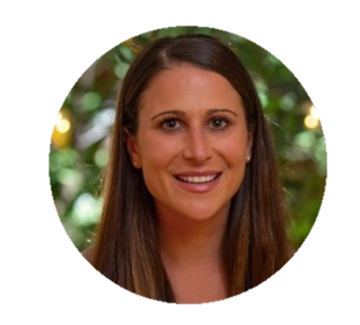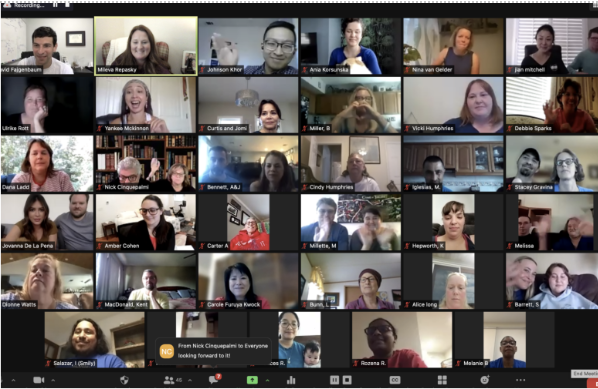Castleman disease: "We will continue the search for a cure until all Castleman disease patients can live full lives!"
Published Apr 16, 2022 • By Charlotte Avril
Mary, Executive Director of the CDCN, shares her experience, her role within the network and the reasons that led her to join patients and their families in their daily fight against Castleman disease.
Read her story below!

Hello Mary, thank you for sharing your story with us on Carenity.
First of all, could you tell us a little bit about yourself?
I am the Executive Director of the CDCN (Castleman Disease Collective Network) and began my work with David and the team as a volunteer in 2014. I live in the Philadelphia area with my husband and 4-month-old daughter.

To learn more about the CDCN, read our article:
“Castleman Disease: The CDCN's unique approach to accelerate research”
Can you tell us about your background and your role within the CDCN? Who do you work with and why did you join the CDCN?
I began working with the CDCN team as I completed my MBA and was several years into my career in Finance. I became aware of the work being done to cure Castleman disease, because of my next-door neighbor and best friend (since we were 3 years old), Caitlin. Caitlin’s boyfriend at the time was really sick and despite traveling to see numerous doctors, and being a medical student himself, couldn’t figure out a diagnosis.
I serve as the CDCN’s Executive Director, after holding several positions, in addition to my "day job" at a mutual fund.
What are your daily missions et activities within the CDCN?
Research is at the center of everything we do. I’m not a scientist, but I help to raise funds and awareness that enable high-impact research to take place. This happens across grants and partnerships as well as individuals. I partner with our Chief Patient Officer, Mileva Repasky, to offer programs and engagement opportunities for our patient and loved one community. Our patient-centric approach is so important to what we do!
Read Mileva's story here:
Castleman disease: “I am dedicating my life to help find a cure for my daughter while also advocating for all patients”
From your personal perspective, what is or are the most important achievement(s) you've contributed to during your experience with the CDCN that you can share with us?
The most important achievements of the CDCN that I contributed to are related to fundraising and community building. From a fundraising perspective, we have set up a major donor program and established an annual fundraising gala (typically held in-person in Philadelphia). We just had our 7th annual event and it's amazing to see how much has changed since our first year! In community building, I am proud of the partnerships that we have built with organizations like the Chan Zuckerberg Initiative, EUSA Pharma, and Medidata Solutions. Each of these groups is so important to our work at the CDCN to help patients and find cures!
What is your personal involvement with patients?
Our Patient and Loved One Summit is one of my favorite days of the year! I love spending time with patients and families who have been impacted by our work. Most of our community is spread out across the U.S. and the world. It’s wonderful to have a weekend together to reconnect with those who have partnered with us to create programs and awareness campaigns and who are now my friends. It’s equally wonderful to meet new patients and loved ones and form those relationships. It’s really special when patients become members of our team to drive our goals for the broader community. And we have some really special patients!

How can patients get involved and be part of the CDCN process and activities?
The CDCN couldn’t have achieved what we have without patient involvement. And there a lot of ways to engage! Patients can donate samples of biospecimens to be used for research, join the registry, join community, fundraise, raise awareness, and attend our annual Patient & Loved One Summit.
If you'd like to learn more about getting involved, feel free to read our article:
“Castleman disease: How to contribute to research?”
Can you tell us more about the clinical trials conducted by the CDCN?
There is currently an FDA-funded clinical trial in the United States for sirolimus, a drug that has been used anecdotally with success in CD patients. The University of Pennsylvania and the University of Arkansas for Medical Sciences launched this clinical trial, and it is open for idiopathic multicentric Castleman disease (iMCD) patients that did not sufficiently get better with, or relapsed on, anti-IL6 treatment (siltuximab or tocilizumab).
To learn more about the trial, visit the CDCN site: CDCN: Clinical Trials
There is also a clinical trial underway at the Peking Union Medical College Hospital in Beijing, China that is exploring the effectiveness and safety of the medications bortezomib, cyclophosphamide and dexamethasone (BCD regimen). The trial is open for patients who are newly diagnosed with iMCD.
To learn more about the trial: CDCN: New Chinese Castleman Disease Network holds launch meeting
What personal benefits do you get from this experience?
I love that the CDCN is a way that I can make a direct impact on healthcare and individuals with rare diseases. I am passionate about our collaborative network approach, which innovates how the research process takes place and enables faster breakthroughs for patients. I hate inefficiency, and we have made great strides to organize the community and strategically prioritize work to reach our goals as fast as possible.
What do you hope to achieve in the long term within the CDCN?
I hope that we will find treatment options for all patients with CD. Right now, the approved therapies currently work in only about one in three patients. We will continue to research and look for cures until all patients with CD can live full lives in length and quality!
What is the latest news from the CDCN and what are its next projects?
One of the most recent projects, outside of laboratory research, is our crowdsourcing of the International Research Agenda for Castleman Disease. The CDCN has published our Collaborative Network Approach, which is a model for advancing patient-centric research. In this model, we engage the entire community of patients, loved ones, physicians, and researchers to share ideas/questions and prioritize the research studies that the CDCN will fund.
Next up, we have partnered with the Chan Zuckerberg Initiative to create a roadmap for rare disease organizations to pursue drug repurposing. (Like the CDCN did with sirolimus). We hope that this work will benefit those in the rare disease community that do not have an effective treatment option.
To learn more about drug repurposing in Castleman disease, read our article here:
“Drug repositioning in Castleman disease”
What advice would you give to someone newly diagnosed with Castleman disease?
As a newly diagnosed patient, it’s important for you or a loved one to educate yourself on the latest recommendations for diagnosis and treatment. I’d also encourage you to become involved in fighting back against Castleman disease. This can be through donating a blood or tissue sample that will be used for research, joining our natural history study (ACCELERATE) and sharing your medical records so that we can learn from patterns across many CD patients, attending our annual Patient and Loved One Summit. You can also join our network to receive updates, help with raising awareness and funds for high-impact research, and share your story as a Castleman Warrior!
How can a social network like Carenity help CD patients?
It is so important for patients with rare diseases to have the ability to connect with other patients and loved ones who are affected. Social media is a great way to reach people globally and learn from their experiences and support one another.
How does a partnership with Carenity fit in with the CDCN approach?
A big part of our work involves supporting patients within our global network. Although we are based in the U.S., we want to benefit all patients around the world, whether that is through information and resources, locating local experts, or connecting with other CD patients. The CDCN’s partnership with Carenity allows us to reach more patients in Europe and share research and insights about their disease. We hope that European patients will get involved in the ways listed here: CDCN: Help find your cure!
Give it a "like" and share your thoughts and questions with the community in the comments below!
Take care!
Comments
You will also like

Testimonial - Castleman disease: "I was relieved to finally find out what I'd been suffering with!".
Jun 8, 2022

 Facebook
Facebook Twitter
Twitter
